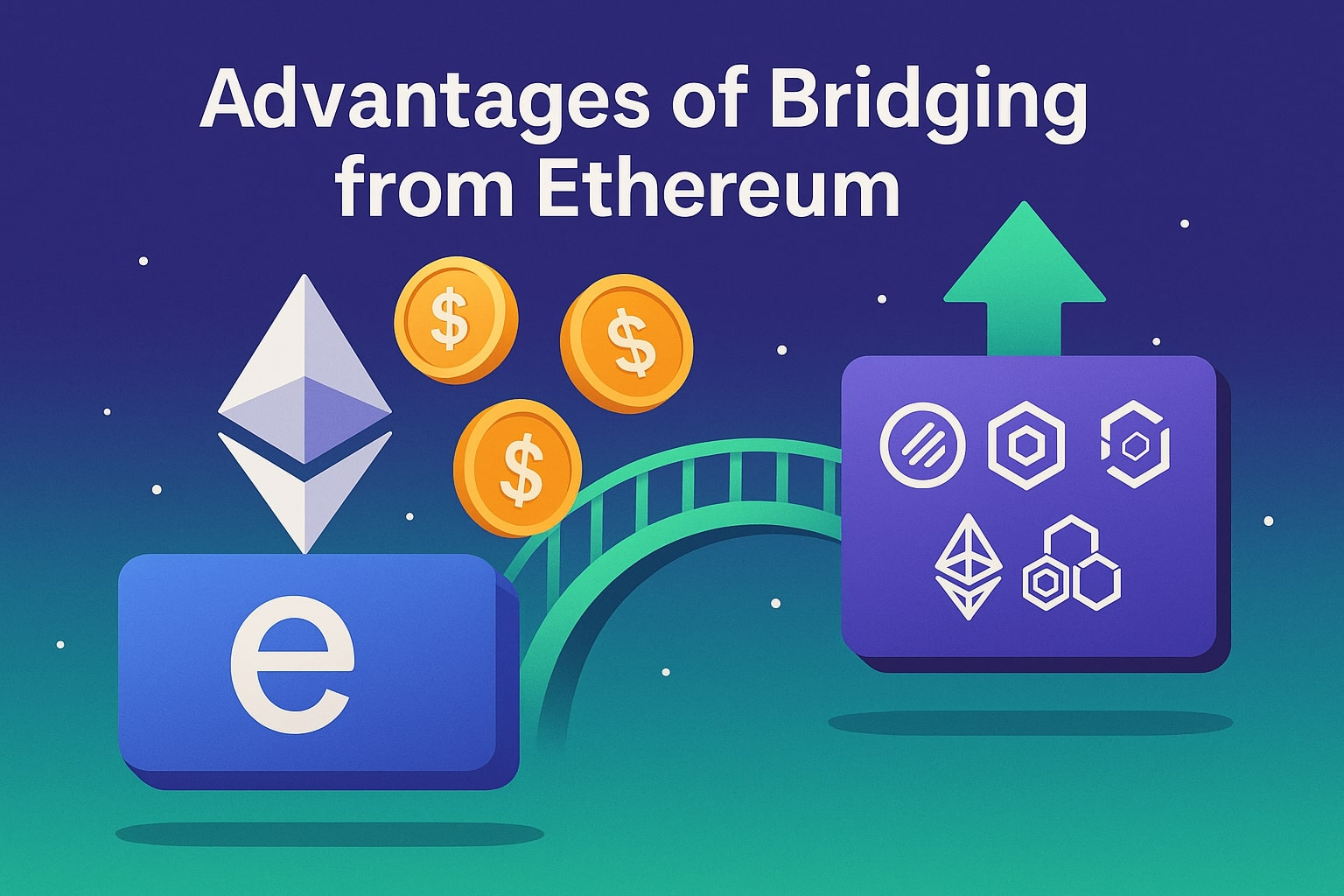In this article, I will explain the Benefits of Bridging From Ethereum. Bridging Ethereum enables users to transfer assets between multiple blockchains, offering improved speed, lower fees, and enhanced access to various DeFi services.
- What is Ethereum Bridging?
- How Cross-Chain Bridges Work
- Key Point & Advantages of Bridging from Ethereum List
- 1. Lower Transaction Fees
- Lower Transaction Fees Features
- 2. Faster Transaction Speeds
- Faster Transaction Speeds Features
- 3. Access to Cheaper DeFi
- Access to Cheaper DeFi Features
- 4.Cross-Chain Asset Mobility
- Cross-Chain Asset Mobility Features
- 5. Better Yield Opportunities
- Better Yield Opportunities Features
- 6.Scalability Relief
- Relief Scalability Features
- 7. Interoperability
- Interoperability Features
- 8.Lower Entry Barriers
- Lower Entry Barriers Features
- 9. Return Flexibility
- Return Flexibility Features
- Pros & Cons: Advantages of Bridging from Ethereum
- Conclusion
- FAQ
Besides these Ethereum bridging benefits, users have more profitable yield opportunities, cross-chain asset mobility, bridging Ethereum’s scalability and interoperability gaps, and flexible, efficient, and easier blockchain access for everyone.
What is Ethereum Bridging?
Ethereum bridging is the process of sending digital assets and/or information from the Ethereum blockchain to a different network. This is done to enable interaction even at the borders of the Ethereum network. Ethereum has high gas fees and constant congestion.
So, users are able to access inexpensive, quicker and more scalable ecosystems such as Binance Smart Chain, Polygon or even Solana.
These Ethereum bridges work by locking Ethereum tokens and issuing the same amount of equivalent tokens at the destination Ethereum bridge, keeping both security and liquidity.
Users are able to use Ethereum bridging to access dApps, decentralized and centralized finance platforms and even NFT marketplaces on different networks without losing value of their assets.
How Cross-Chain Bridges Work
The most important parts of how cross-chain bridges operate are explained below.
Asset Locking: Locks up the original tokens on the source blockchain in a smart contract or custodian wallet.
Token Minting: New blockchain tokens are minted, wrapped in the equivalent of the locked assets.
Verification: The transaction is confirmed and the bridge locked assets are verified using smart contracts, validators, or relayers.
Token Transfer: Users get the equivalent wrapped new tokens on the target blockchain, which can be used for trade, DeFi, or dApps.
Redeeming: Wrapped tokens get burned on the destination blockchain and the original locked tokens are released.
Security Measures: Fraud and double-spending prevention using oracle and decentralized validator, multi-signature setups.
Key Point & Advantages of Bridging from Ethereum List
| Key Point | Description |
|---|---|
| Lower Transaction Fees | Bridges help avoid Ethereum’s high gas costs by moving assets to cheaper chains. |
| Faster Transaction Speeds | Transactions process quicker on alternative blockchains with less congestion. |
| Access to Cheaper DeFi | Users can explore affordable DeFi platforms outside Ethereum. |
| Cross-Chain Asset Mobility | Enables seamless movement of assets across multiple blockchain ecosystems. |
| Better Yield Opportunities | Access to higher staking and farming rewards on other networks. |
| Scalability Relief | Reduces congestion on Ethereum by distributing traffic to other chains. |
| Interoperability | Promotes communication and utility across diverse blockchain platforms. |
| Lower Entry Barriers | New users benefit from cheaper fees and easier access to DeFi. |
| Return Flexibility | Allows assets to move back to Ethereum when needed, ensuring liquidity. |
1. Lower Transaction Fees
Ethereum users benefit greatly from the low transaction costs of bridging. During periods of high congestion, Ethereum suffers from extraordinarily high gas costs which can easily deter average users or smaller investors.

By bridging assets onto different chains with more economical cost structures, users can easily perform trades, staking, or even interact with DeFi protocols. Lower fees mean increased access to blockchains which encourages the use of many more dApps.
Ethereum fees are still unbelievably high and the few chains that can easily accept Ethereum, do charge high fees so bridging does provide a more cost effective solution.
Lower Transaction Fees Features
- Reduced Gas Costs: Bridging helps users avoid Ethereum gas fees.
- Affordable Micro-Transactions: Small trades and interactions can become profitable.
- Cost-Efficient DeFi Participation: Users can access DeFi platforms with low cost barriers.
2. Faster Transaction Speeds
Faster transaction speeds are advantageous when bridging from Ethereum since they help alleviate network congestion. There are times on Ethereum when network congestion becomes so bad that it takes far too long to check even the simplest of transfers.

Users that relocate their assets to blockchains that handle more transactions per second are greeted to near instant transaction confirmations. This improvement increases the efficiency of trading, lending, or gaming.
The time advantage is crucial when it comes to actions that need to be done quickly, which is when arbitrage or yield farming comes in. Nobody wants to stay on the Ethereum network, they want to bridge, so they want to finish their yield farming without any delays.
Faster Transaction Speeds Features
- Quick Confirmations: Other chains can process transactions faster than the congested Ethereum chain.
- Time-Sensitive Operations: Perfect for arbitrage, trading, and yield farming where time is crucial.
- Improved dApp Efficiency: Using decentralized applications becomes more effective.
3. Access to Cheaper DeFi
One major advantage of bridging to Ethereum is the access to cheaper DeFi services which opens up financial services otherwise too expensive to transact on the main network.

Many DeFi services on Ethereum, structuring yield, lending, or staking, and other such services backed by crypto wallets, require transactions which can end up costing higher gas fees. Therefore, by bridging the assets to chains which incur lower operational costs, users can access DeFi even cheaper through similar services.
The lower cost of services means investing at a lower cost which makes DeFi accessible to a wider audience. In the end, bridging is a way to maximize returns while minimizing costs on the decentralized financial ecosystem.
Access to Cheaper DeFi Features
- Lower DeFi Interaction Costs: Users can interact with DeFi protocols for low fees readily accessible.
- Wider Choices: Users can use DeFi services that are not financially viable on Ethereum.
- Small Investor Friendly: Small investors can participate in lending and farming pools.
4.Cross-Chain Asset Mobility
Cross-chain bridging from Ethereum has a profound advantage of enabling users the cross-chain mobility of assets. Users don’t have to stay only within the Ethereum network.

Users can bridge assets to networks like Binance Smart Chain, Polygon, or Solana where they can be traded, staked, or utilized in dApps. This mobility improves portfolio flexibility because investors can quickly take advantage of opportunities across multiple platforms without liquidating holdings.
This increased portfolio flexibility encourages a more integrated blockchain ecosystem where assets can hold their value while gaining new utility. Bridging guarantees true interoperability enabling users to maximize the functionality and reach of their digital assets.
Cross-Chain Asset Mobility Features
- Value Retention: Transfer assets across multiple blockchains and retain their value.
- Adjusted Portfolios: Shift investments across chains for better profit returns.
- Improved Asset Functionality: Use the exact assets in various ecosystems and applications.
5. Better Yield Opportunities
Having better yield opportunities is a key advantage of bridging from Ethereum because it provides users with access to different reward structures across multiple chains.
Ethereum is notorious for high fees which often diminishes the profitability of staking or farming and renders smaller deposits considerable less worthwhile.

Moving assets onto blockchains with diversified DeFi ecosystems and lower costs enables users to access higher annual percentage yields (APYs) and new incentive programs.
This flexibility allows users to optimize returns by participating in multiple liquidity pools, farming campaigns, or staking systems which may otherwise not be available on Ethereum. Bridging, therefore, enhances earning potential and allows users to exercise greater control over their passive income generation strategies.
Better Yield Opportunities Features
- High APYs: Switch to other chains that offer better returns for farming and staking.
- Diverse Rewards: Take part in reward systems which aren’t available in Ethereum.
- Maximized Profits: Track profits and spread earnings on different chains to increase profits.
6.Scalability Relief
Bridging from and to Ethereum has the advantage of scalability relief because it allows Ethereum to scale a little easier. Since there are millions of customers fighting to use the network at the same time, the transactions slow down and cost a fortune.

Bridging and shifting to other blockchains helps Ethereum deal with the load stress, and Ethereum helps the others work more smoothly. This benefits the other chains by providing abundant network resources which lowers Ethereum’s network traffic.
Bridging Ethereum to Ethereum classic helps both chains work more smoothly, and gradually, latency relief improves the health of the entire multi-chain ecosystem by relieving the stress on a single network. This improves the growth and multiprocessing of the network, which helps decentralization more.
Relief Scalability Features
- Less Traffic on Ethereum: Shifts traffic to other chains.
- Lower Ethereum Congestion: More responsive transactions and less lag.
- Support the Growth of Multi-Chain: Helps sustain efficient blockchains.
7. Interoperability
Interoperability from Etherum’s network is very important since it unites previously siloed blockchain networks. Users can now engage and use different chains without the hassle of converting their assets.

This removes the challenge of operating across multiple chains and platforms. This multifaceted usage of digital assets increases their utility and broadens asset mobility. These assets become even more helpful and flexible.
The cross-chain adoption of dApps enhances the user empowerment and eases the developer’s work. This is all possible with interoperability. Bridging Etherum assets to other blockchain tech gives endless collaboration opportunities, and greatly advances the connected decentral economy.
Interoperability Features
- Cross-Chain Functionality: Ethereum-based assets can use other apps in different chains.
- Greater Usability: Decentralized apps can use tools from other blockchains.
- Integrated Network: Fosters the interconnection and growth of blockchain systems.
8.Lower Entry Barriers
An example of beneficial use of bridging from Ethereum is lowering entry barriers. Ethereum has very high gas fees and as a result a large number of potential users interested in DeFi and NFTs and even simple Ethereum Apps never even consider the Ethereum blockchain.

Bridging to other networks with much lower costs opens the gateways to financial middle class to take their first steps into blockchain without the high risks of losing large amounts of money.
This fosters blockchain technological growth from the bottom to the top and as a result brings in users from other parts of the world where these users were completely ignored because of high costs of transactions on many other interoperable chains. This is how bridging helps in making blockchain accessible to everyone and not only the rich.
Lower Entry Barriers Features
- Reduced Barriers to Engagement: Lowered costs allow wider participation to the ecosystem.
- Accessibility to Investments: Smaller DeFi, NFT, other services users can easily access to.
- Wider Participation to Blockchain: Simplifies access and use to the ecosystem.
9. Return Flexibility
One of the most useful things someone can gain from a bridge on Ethereum is the return flexibility which lets a user move their assets back and forth on the chains as needed.

Unlike a one-way transfer, bridging allows investors to explore other blockchains and return to Ethereum at a later time and if the conditions are right. This is particularly advantageous for mitigating risk, capitalizing on new yield opportunities, or returning to Ethereum’s vast liquidity and market.
Bridging is advantageous to the user as it allows them not to be confined to one ecosystem, which enhances their investment control, adaptability, and strategy.
Return Flexibility Features
- Moveable Assets: Move assets back to Ethereum instantaneously if and when needed.
- Ethereum Liquidity Retention: Maintain access to Ethereum’s extensive liquidity pools.
- Cross-Chain Investments: Move and fluctuate investment strategies across chains for.
Pros & Cons: Advantages of Bridging from Ethereum
Pros
- Saves on Transaction Fees: Bypass Ethereum’s gas fees and spend much less money.
- Increased Speed: Receive quicker confirmations on less congested chains.
- Reduced Cost to Access DeFi: Access DeFi protocols more cheaply.
- Mobility Between Chains: Move assets freely across different frameworks.
- Increased Yield Opportunities: Access higher APYs and more varied staking/farming yields.
- Ethereum Relief: Enjoy less congestion and smooth transactions on Ethereum.
- Interoperability: Use Ethereum assets with other blockchains.
- Broader Reach: Enable small investors to participate without being priced out.
- Flexibility of Return: Move assets back to Ethereum at will for liquidity.
Cons
- Bridges: A less secure form imposes higher security risks.
- Bugs: Fund loss may occur due to improper safeguards against common threats.
- Loss of Control: Some bridges rely on custodians or validators.
- Variation: Not all chains share the same liquidity depth as Ethereum.
- Complexity: Bridging involves various transactions which may be complex for novices.
- Transaction Delays: Network congestion on either chain can still cause transfer slowness.
- Fee Variability: Although lower, changes in popularity and destination chain fees can still occur.
- Limited Support: There are limited support frameworks, and information can be traced across all bridges.
Conclusion
In conclusion, bridging from Ethereum has unique benefits that improve the usability, effectiveness, and profit potential of digital assets. Lowering transaction costs while enabling faster transfers alleviates the DeFi bridging costs, making the Access over Transfers Ratio more favorable.
Participation in Ethereum and DeFi provides cross-chain asset liquidity, better yield control, and increased turnover flexibility, thereby offering users better overall control. Further yield flexibility on the DeFi Ethereum Chain, along with yield on other chains, means passive income growth from wallets on different chains.
Also, the Ethereum Bridge, along with other gateways, increases the level of blockchain participation on different chains. Overall, bridging Ethereum chains and DeFi has the flexibility to maximize yield while providing diverse investments beyond Ethereum.
FAQ
Why does bridging reduce transaction fees?
By moving assets to blockchains with lower gas costs, users can perform transactions and interact with DeFi platforms at a fraction of Ethereum’s high fees.
How does bridging improve transaction speeds?
Alternative chains often handle higher throughput, so transfers and smart contract interactions complete faster than on congested Ethereum.
Can bridging help earn better yields?
Yes, bridging provides access to varied DeFi platforms offering higher staking, farming, or liquidity rewards that may not be available on Ethereum.








